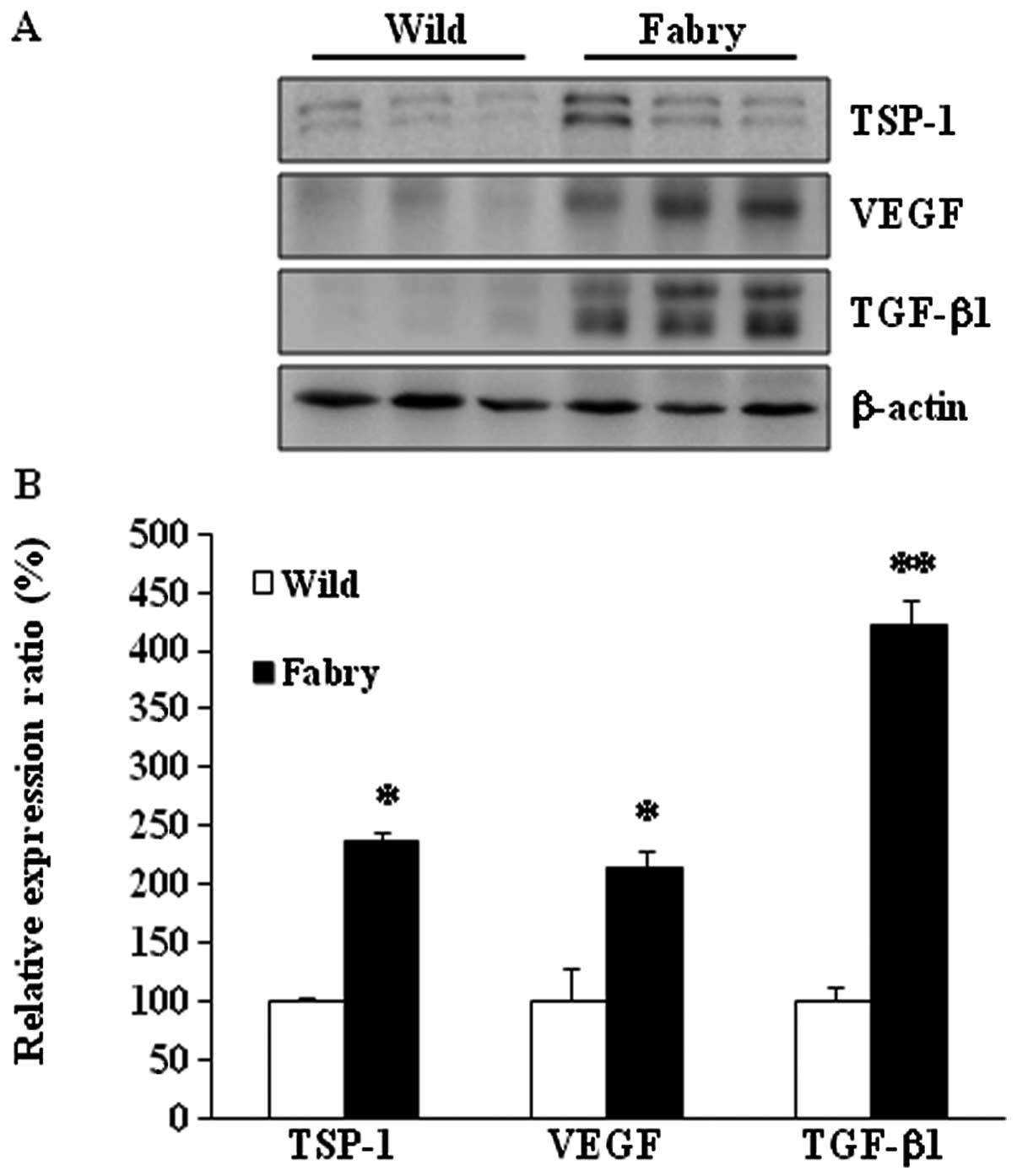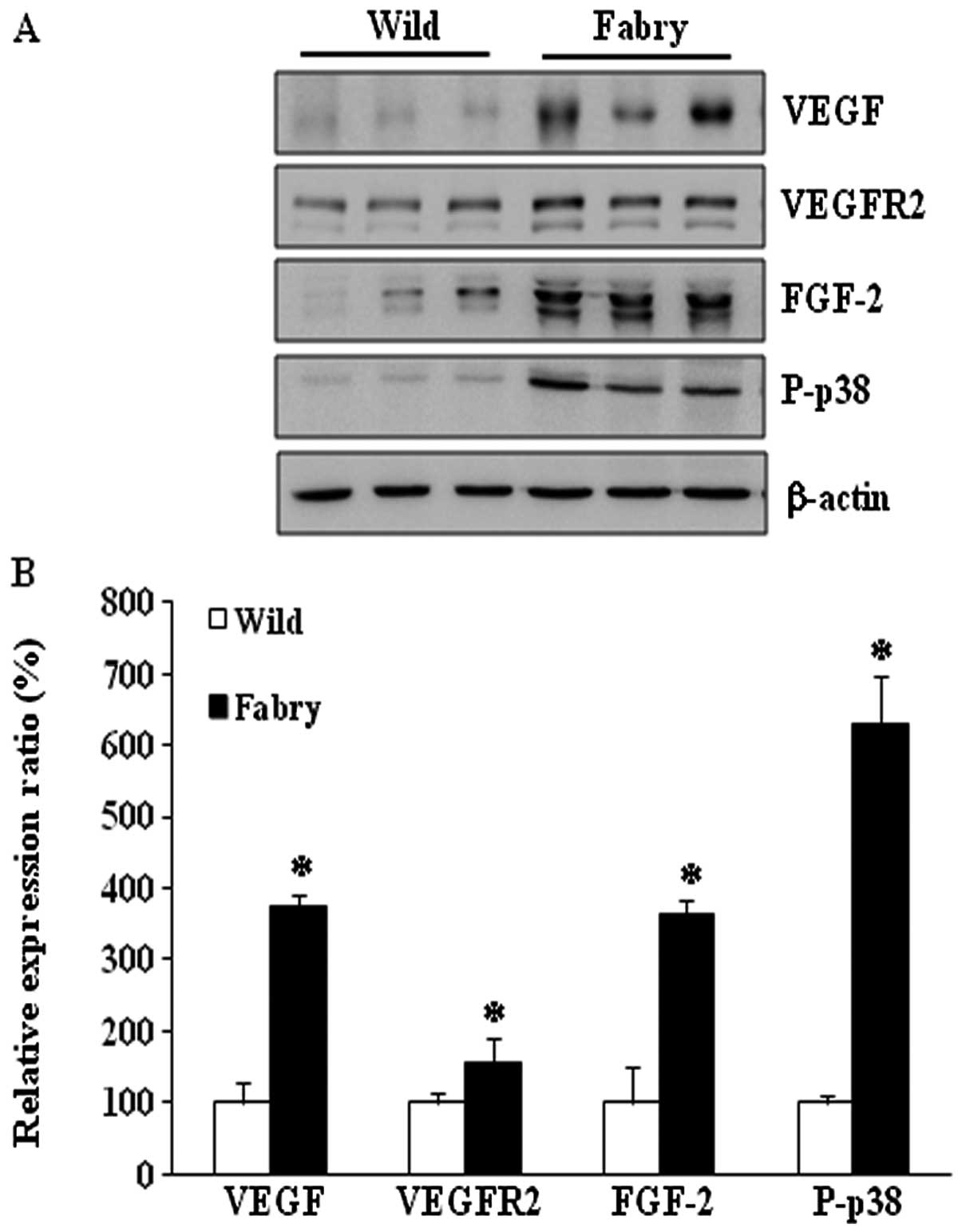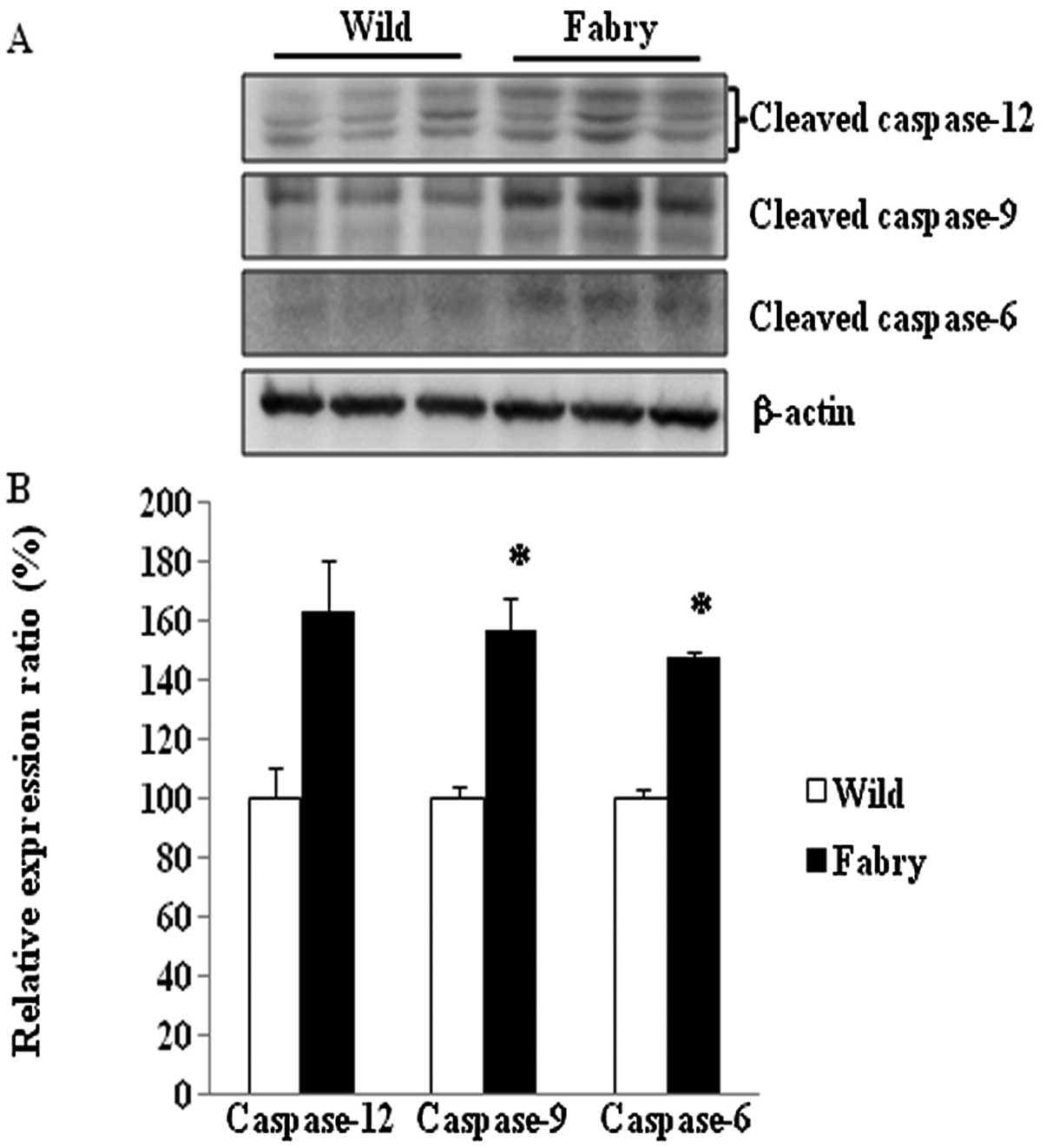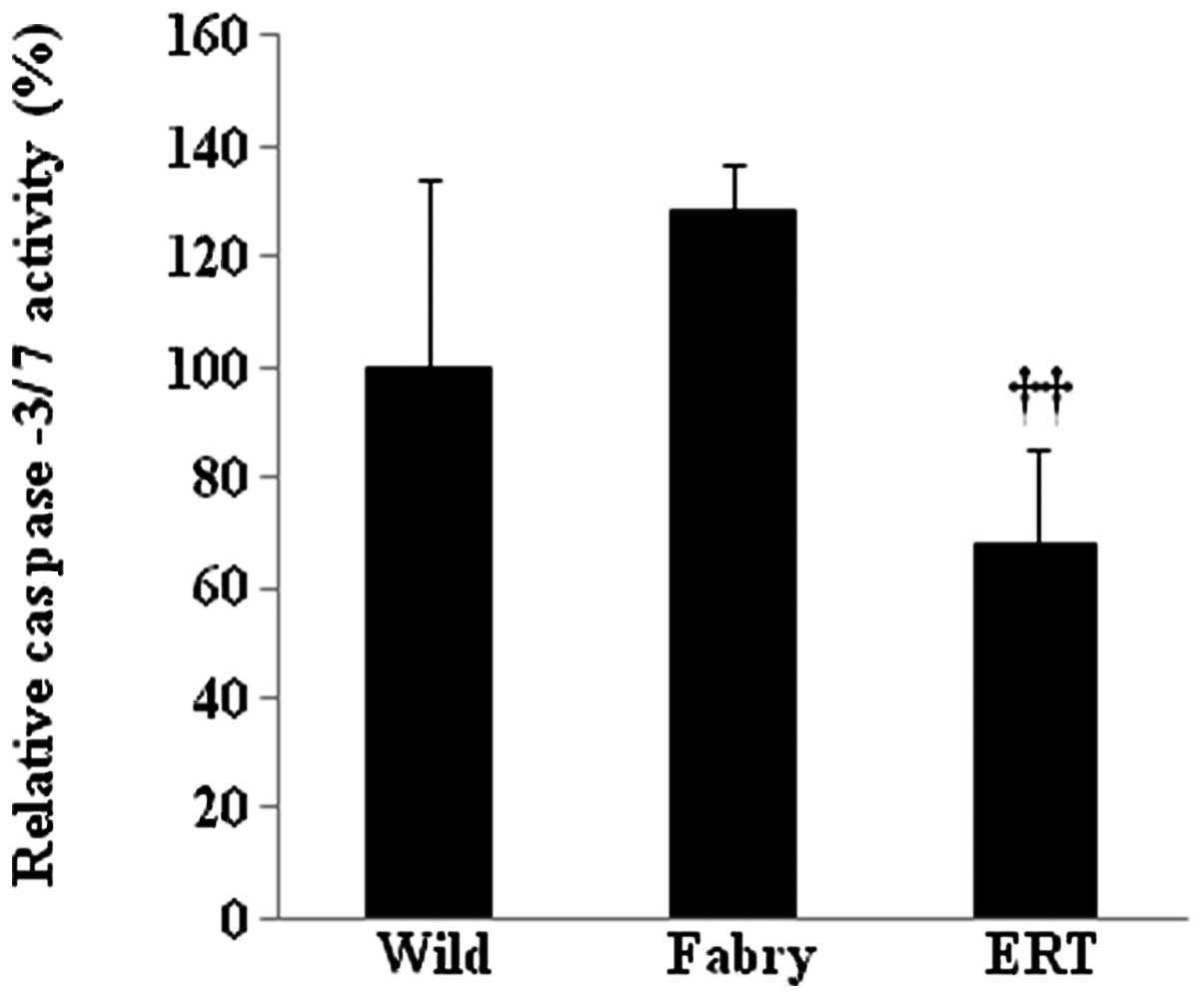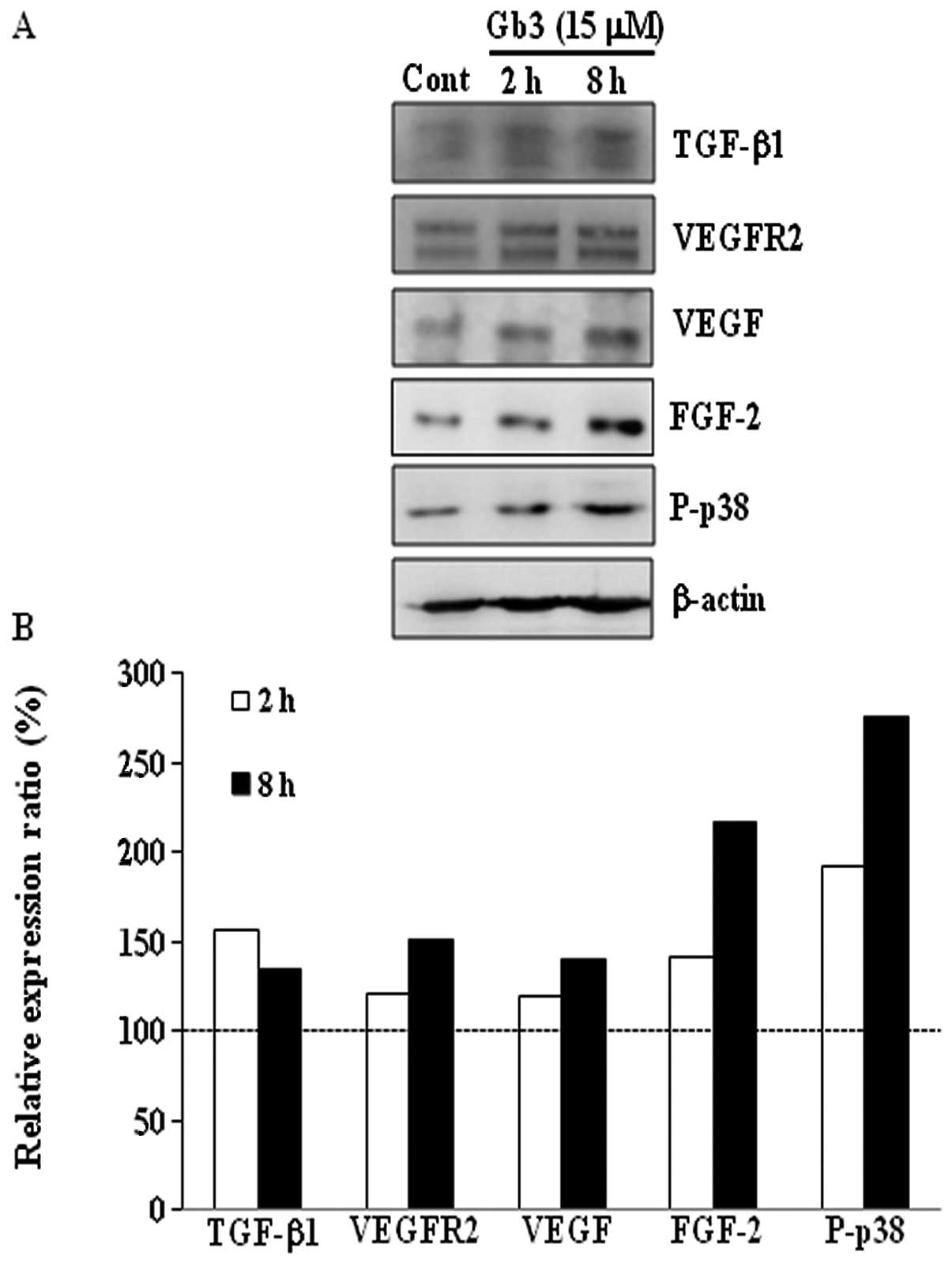|
1
|
Brady RO, Gal AE, Bradley RM, Martensson
E, Warshaw AL and Laster L: Enzymatic defect in Fabry’s disease.
Ceramidetrihexosidase deficiency. New Engl J Med. 276:1163–1167.
1967.
|
|
2
|
Kint JA: The enzyme defect in Fabry’s
disease. Nature. 227:11731970.
|
|
3
|
Desnick RJ, Ioannou YA and Eng CM:
Alpha-galactosidase A deficiency: Fabry disease. The Metabolic and
Molecular Bases of Inherited Disease. Scriver CR, Beaudet AL, Sly
WS and Valle D: 8th edition. McGraw-Hill; New York, NY: pp.
3733–3774. 2001
|
|
4
|
Tondel C, Bostad L, Hirth A and Svarstad
E: Renal biopsy findings in children and adolescents with Fabry
disease and minimal albuminuria. Am J Kidney Dis. 51:767–776. 2008.
View Article : Google Scholar : PubMed/NCBI
|
|
5
|
Ohshima T, Murray GJ, Swaim WD, et al:
alpha-Galactosidase A deficient mice: a model of Fabry disease.
Proc Nat Acad Sci USA. 94:2540–2544. 1997. View Article : Google Scholar : PubMed/NCBI
|
|
6
|
Shu L, Murphy HS, Cooling L and Shayman
JA: An in vitro model of Fabry disease. J Am Soc Nephrol.
16:2636–2645. 2005. View Article : Google Scholar : PubMed/NCBI
|
|
7
|
Bodary PF, Shen Y, Vargas FB, et al:
Alpha-galactosidase A deficiency accelerates atherosclerosis in
mice with apolipoprotein E deficiency. Circulation. 111:629–632.
2005. View Article : Google Scholar : PubMed/NCBI
|
|
8
|
Eitzman DT, Bodary PF, Shen Y, et al:
Fabry disease in mice is associated with age-dependent
susceptibility to vascular thrombosis. J Am Soc Nephrol.
14:298–302. 2003. View Article : Google Scholar : PubMed/NCBI
|
|
9
|
Sanchez-Nino MD, Sanz AB, Carrasco S, et
al: Globo-triaosylsphingosine actions on human glomerular
podocytes: implications for Fabry nephropathy. Nephrol Dial
Transplant. 26:1797–1802. 2011. View Article : Google Scholar : PubMed/NCBI
|
|
10
|
Chen S, Hong SW, Iglesias-de la Cruz MC,
Isono M, Casaretto A and Ziyadeh FN: The key role of the
transforming growth factor-beta system in the pathogenesis of
diabetic nephropathy. Ren Fail. 23:471–481. 2001. View Article : Google Scholar : PubMed/NCBI
|
|
11
|
Hayashida T, Decaestecker M and Schnaper
HW: Cross-talk between ERK MAP kinase and Smad signaling pathways
enhances TGF-beta-dependent responses in human mesangial cells.
FASEB J. 17:1576–1578. 2003.PubMed/NCBI
|
|
12
|
Pollman MJ, Naumovski L and Gibbons GH:
Vascular cell apoptosis: cell type-specific modulation by
transforming growth factor-beta1 in endothelial cells versus smooth
muscle cells. Circulation. 99:2019–2026. 1999. View Article : Google Scholar : PubMed/NCBI
|
|
13
|
Ferrara N: Vascular endothelial growth
factor: basic science and clinical progress. Endocr Rev.
25:581–611. 2004. View Article : Google Scholar : PubMed/NCBI
|
|
14
|
Flyvbjerg A: Inhibition and reversibility
of renal changes: lessons from diabetic kidney disease. Acta
Paediatr Suppl. 95:83–92. 2006. View Article : Google Scholar : PubMed/NCBI
|
|
15
|
Moore DF, Krokhin OV, Beavis RC, et al:
Proteomics of specific treatment-related alterations in Fabry
disease: a strategy to identify biological abnormalities. Proc Natl
Acad Sci USA. 104:2873–2878. 2007. View Article : Google Scholar : PubMed/NCBI
|
|
16
|
Park ES, Choi JO, Park JW, Lee MH, Park HY
and Jung SC: Expression of genes and their responses to enzyme
replacement therapy in a Fabry disease mouse model. Int J Mol Med.
24:401–407. 2009.PubMed/NCBI
|
|
17
|
Venkatesha S, Hanai J, Seth P, Karumanchi
SA and Sukhatme VP: Lipocalin 2 antagonizes the proangiogenic
action of ras in transformed cells. Mol Cancer Res. 4:821–829.
2006. View Article : Google Scholar : PubMed/NCBI
|
|
18
|
Dameron KM, Volpert OV, Tainsky MA and
Bouck N: Control of angiogenesis in fibroblasts by p53 regulation
of thrombospondin-1. Science. 265:1582–1584. 1994. View Article : Google Scholar : PubMed/NCBI
|
|
19
|
Chen H, Herndon ME and Lawler J: The cell
biology of thrombospondin-1. Matrix Biol. 19:597–614. 2000.
View Article : Google Scholar : PubMed/NCBI
|
|
20
|
Zhang YW, Su Y, Volpert OV and Vande Woude
GF: Hepatocyte growth factor/scatter factor mediates angiogenesis
through positive VEGF and negative thrombospondin 1 regulation.
Proc Natl Acad Sci USA. 100:12718–12723. 2003. View Article : Google Scholar
|
|
21
|
Jimenez B, Volpert OV, Crawford SE,
Febbraio M, Silverstein RL and Bouck N: Signals leading to
apoptosis-dependent inhibition of neovascularization by
thrombospondin-1. Nat Med. 6:41–48. 2000. View Article : Google Scholar : PubMed/NCBI
|
|
22
|
Sargiannidou I, Zhou J and Tuszynski GP:
The role of thrombospondin-1 in tumor progression. Exp Biol Med
(Maywood). 226:726–733. 2001.PubMed/NCBI
|
|
23
|
Kang DH, Anderson S, Kim YG, et al:
Impaired angiogenesis in the aging kidney: vascular endothelial
growth factor and thrombospondin-1 in renal disease. Am J Kidney
Dis. 37:601–611. 2001. View Article : Google Scholar : PubMed/NCBI
|
|
24
|
Yevdokimova N, Wahab NA and Mason RM:
Thrombospondin-1 is the key activator of TGF-beta1 in human
mesangial cells exposed to high glucose. J Am Soc Nephrol.
12:703–712. 2001.PubMed/NCBI
|
|
25
|
Bornstein P: Thrombospondins as
matricellular modulators of cell function. J Clin Invest.
107:929–934. 2001. View
Article : Google Scholar : PubMed/NCBI
|
|
26
|
Hugo C and Daniel C: Thrombospondin in
renal disease. Nephron Exp Nephrol. 111:e61–e66. 2009. View Article : Google Scholar : PubMed/NCBI
|
|
27
|
Ferrara N and Gerber HP: The role of
vascular endothelial growth factor in angiogenesis. Acta Haematol.
106:148–156. 2001. View Article : Google Scholar : PubMed/NCBI
|
|
28
|
Neufeld G, Cohen T, Gengrinovitch S and
Poltorak Z: Vascular endothelial growth factor (VEGF) and its
receptors. FASEB J. 13:9–22. 1999.PubMed/NCBI
|
|
29
|
Narasimhan P, Liu J, Song YS, Massengale
JL and Chan PH: VEGF stimulates the ERK 1/2 signaling pathway and
apoptosis in cerebral endothelial cells after ischemic conditions.
Stroke. 40:1467–1473. 2009. View Article : Google Scholar : PubMed/NCBI
|
|
30
|
Ferrari G, Pintucci G, Seghezzi G, Hyman
K, Galloway AC and Mignatti P: VEGF, a prosurvival factor, acts in
concert with TGF-beta1 to induce endothelial cell apoptosis. Proc
Natl Acad Sci USA. 103:17260–17265. 2006. View Article : Google Scholar : PubMed/NCBI
|
|
31
|
Nakagawa T, Lan HY, Zhu HJ, Kang DH,
Schreiner GF and Johnson RJ: Differential regulation of VEGF by
TGF-beta and hypoxia in rat proximal tubular cells. Am J Physiol
Renal Physiol. 287:F658–F664. 2004. View Article : Google Scholar : PubMed/NCBI
|
|
32
|
Seghezzi G, Patel S, Ren CJ, et al:
Fibroblast growth factor-2 (FGF-2) induces vascular endothelial
growth factor (VEGF) expression in the endothelial cells of forming
capillaries: an autocrine mechanism contributing to angiogenesis. J
Cell Biol. 141:1659–1673. 1998. View Article : Google Scholar
|
|
33
|
Li D, Zhang C, Song F, Lubenec I, Tian Y
and Song QH: VEGF regulates FGF-2 and TGF-beta1 expression in
injury endothelial cells and mediates smooth muscle cell
proliferation and migration. Microvasc Res. 77:134–142. 2009.
View Article : Google Scholar : PubMed/NCBI
|
|
34
|
Nakagawa T, Li JH, Garcia G, et al:
TGF-beta induces proangiogenic and antiangiogenic factors via
parallel but distinct Smad pathways. Kidney Int. 66:605–613. 2004.
View Article : Google Scholar : PubMed/NCBI
|
|
35
|
Yu L, Hebert MC and Zhang YE: TGF-beta
receptor-activated p38 MAP kinase mediates Smad-independent
TGF-beta responses. EMBO J. 21:3749–3759. 2002. View Article : Google Scholar : PubMed/NCBI
|
|
36
|
Iglesias-de la Cruz MC, Ziyadeh FN, Isono
M, et al: Effects of high glucose and TGF-beta1 on the expression
of collagen IV and vascular endothelial growth factor in mouse
podocytes. Kidney Int. 62:901–913. 2002.PubMed/NCBI
|
|
37
|
Schiffer M, Bitzer M, Roberts IS, et al:
Apoptosis in podocytes induced by TGF-beta and Smad7. J Clin
Invest. 108:807–816. 2001. View Article : Google Scholar : PubMed/NCBI
|
|
38
|
Yang W, Wang J, Shi L, et al: Podocyte
injury and overexpression of vascular endothelial growth factor and
transforming growth factor-beta 1 in adriamycin-induced nephropathy
in rats. Cytokine. 59:370–376. 2012. View Article : Google Scholar : PubMed/NCBI
|
|
39
|
Schmitz I, Kirchhoff S and Krammer PH:
Regulation of death receptor-mediated apoptosis pathways. Int J
Biochem Cell Biol. 32:1123–1136. 2000. View Article : Google Scholar : PubMed/NCBI
|
|
40
|
De Francesco PN, Mucci JM, Ceci R, Fossati
CA and Rozenfeld PA: Higher apoptotic state in Fabry disease
peripheral blood mononuclear cells: effect of
globotriaosylceramide. Mol Genet Metab. 104:319–324.
2011.PubMed/NCBI
|
|
41
|
Valbuena C, Oliveira JP, Carneiro F, et
al: Kidney histologic alterations in α-galactosidase-deficient
mice. Virchows Arch. 458:477–486. 2011.
|
|
42
|
Noel LH, Laurent B and Grunfeld JP: Renal
biopsies in Fabry disease: a multicenter French study. Nephrol
Ther. May 14–2012.(Epub ahead of print) (In French).
|
|
43
|
Moore DF, Goldin E, Gelderman MP, et al:
Apoptotic abnormalities in differential gene expression in
peripheral blood mononuclear cells from children with Fabry
disease. Acta Paediatr Suppl. 97:48–52. 2008. View Article : Google Scholar : PubMed/NCBI
|















